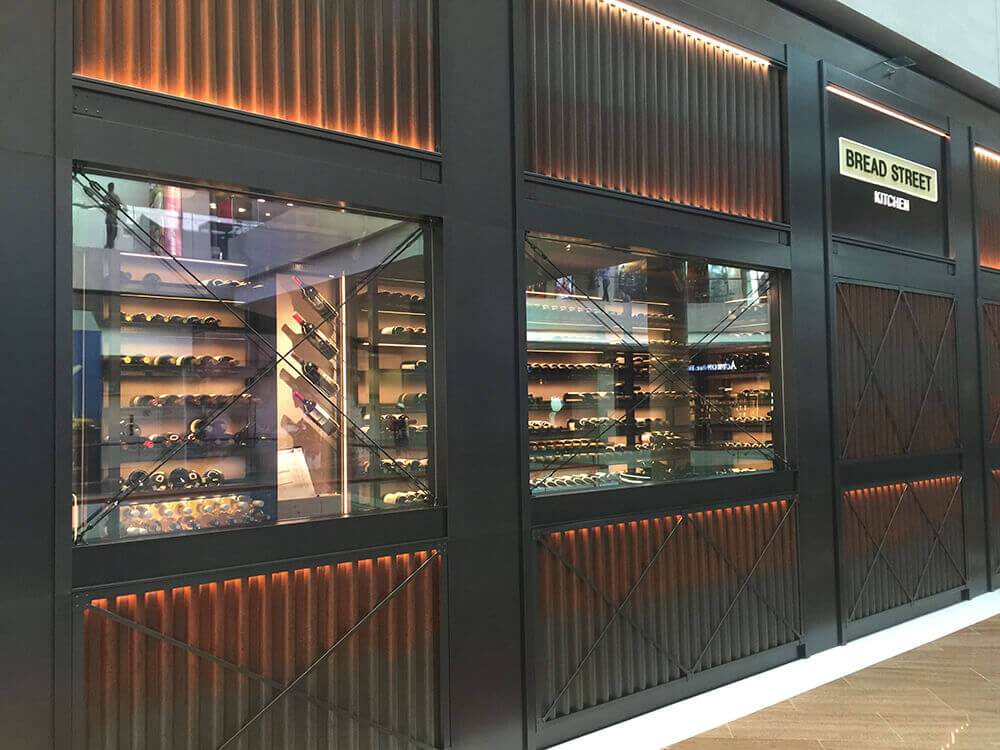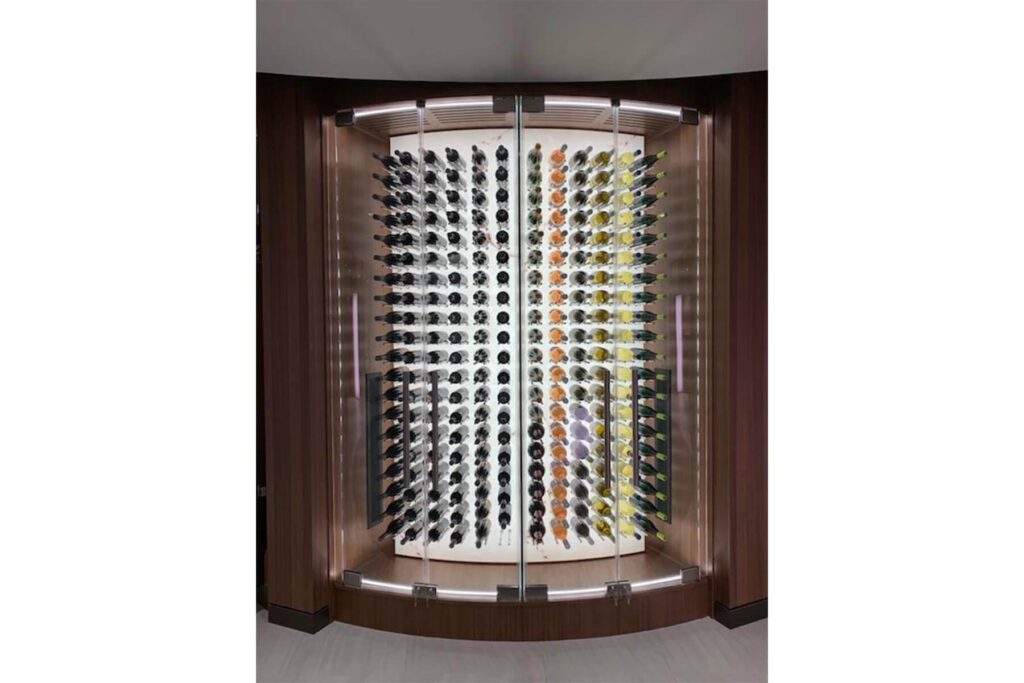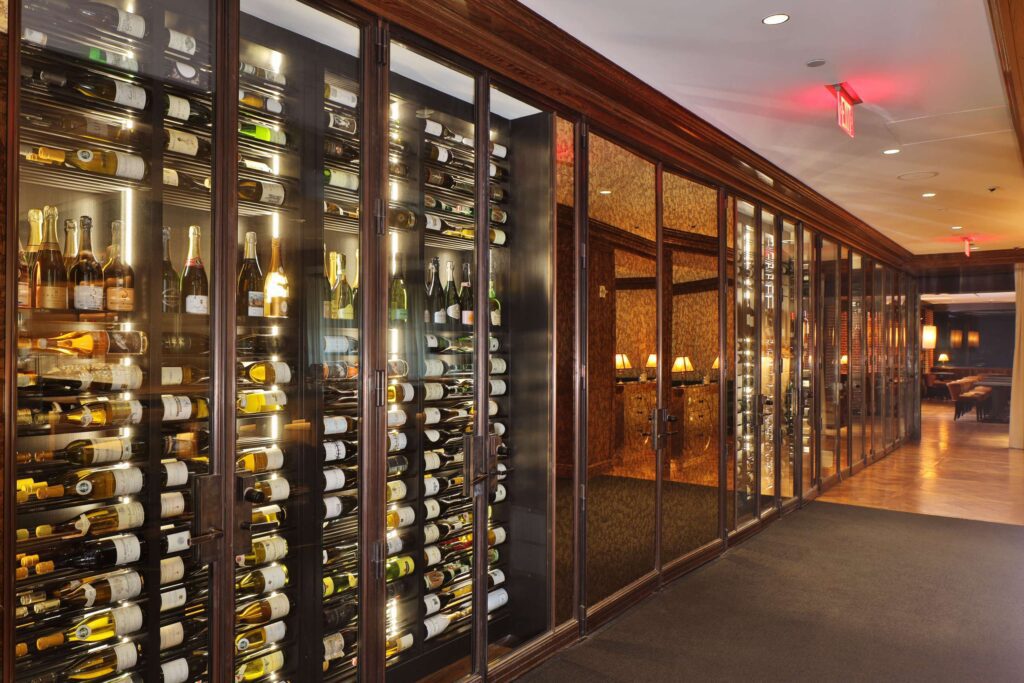The growth rate of wine sales around the globe is on the rise, including the consumption of wine in restaurants. Take the United States as an example. More Americans are appreciating the pairing of food with wine and not just enjoying it as a pre-dinner drink. From casual establishments to upscale eateries, restaurants have embraced this shift and wine has become integral to more dining experiences. There are wider selections to choose from and the vintages being offered are more sophisticated than ever. As a result, restaurant owners have started to implement wine displays in their restaurants.
Along with sourcing a tempting wine menu, restaurant owners around the world are experimenting with the variety of ways wine can be showcased. Wine walls delineate bar areas from dining rooms. Wine displays behind bars are part of the interior architecture of restaurants. An elegant wine enclosure not only elevates the overall look and feel of a restaurant but also has the potential to entice wine consumption and drive up high-margin profits. For instance, Bread Street Kitchen in Singapore designed and built two stunning wine displays in its Marina Bay Sands restaurant. One feature is visible to passersby from the shopping mall, while the other adds a dramatic touch to the interior design. Whether a restaurant owner decides to display wine to complement the decor of the space, or to store or sell more, exhibiting wine just makes sense.
Since every inch devoted to showcasing wine equates to that much less space for tables, it is important that restaurant owners educate themselves on several factors that influence the success of a wine space.

Incorporate Cooling From The Outset
The design of a display must correlate to the right cooling unit needed to maintain a stable environment. To this end, it is important that a designer and engineer collaborate during the planning phase of a wine display project.
No one is more familiar with the importance of proper planning than Vineyard Wine Cellars. The company spearheaded the wine tower project in the Delta Sky Club at Austin International Airport, a complex application with no space to hold ductwork or mechanicals. There was also nowhere to conceal supply and return grilles without disrupting the ultra-modern look-and-feel of the tower. Being involved in the planning stage enabled Vineyard Wine Cellars to select complementary cooling units that could adapt to the unique challenges of the project. Essentially, the Wine Guardian solution was incorporated into the blueprint, as opposed to being an afterthought.
How To Find The Right Cooling Unit
Several variables influence which cooling system will best complement your wine display, including the size of the space, location, and construction.
Size of Space
The size of the wine display is one of the factors that determine which cooling system will best maintain a pristine environment. Heat load calculators are available to anticipate those needs. Moreover, restaurant owners need to evaluate cubic footage versus square footage, because the volume of a space is the correct measurement when it comes to cooling air (versus the area).
Volume and Type of Glass

The type of glass that makes up a display also plays a role in identifying the right cooling system. A wine wall consisting of four sides of floor-to-ceiling glass will require a greater cooling capacity than one with little or no glass. Similarly, double-paned glass provides greater insulation than plate glass and is able to maintain cooler temperatures with fewer BTUs.
An additional note about glass involves fogging, which can be avoided by selecting a cooling unit that does not circulate air directly onto glass walls.
Humidity
Consideration must be taken when restaurants are located in humid climates or dry ones. Humidity levels over 70% can cause mold and glue on labels to break down. Levels below 50% can result in cracked corks and degraded wine. Standard cooling systems remove humidity from the air, but they don’t add it back. A cooling unit with a built-in humidifier is necessary to increase humidity levels, particularly in drier geographic areas The right system will also need to feature an all-aluminum evaporator coil to prevent rust and corrosion associated with elevated humidity.
Ambient Temperature
In addition to humidity, the ambient temperature surrounding an application influences which cooling unit will be most effective. For example, if a wine enclosure is in a heavily air-conditioned restaurant, this space will require less cooling capacity than one kept at a warmer temperature. Cooling units that operate at a lower capacity than needed may run excessively and lower the relative humidity, while systems that provide more cooling capacity than is needed may cool the space very quickly, but will keep it from removing enough humidity. Both of these scenarios jeopardize the quality of the wine.
Lighting
Lighting in restaurants differs from residential spaces because some lights are left on all day and night. Lights generate heat, which will elevate the temperature within the wine display, necessitating a cooling unit with more capacity.
How Often Door is Opened
Unless a wine space is only being used for storage or to add to the decor, most displays will be accessed by servers repeatedly throughout the day. Every time a door is opened the pristine environment is disturbed, which is why a powerful enough cooling system is needed to restore balance quickly.
Type of Wine Being Stored
Lastly, most restauranteurs know the difference between storing and serving temperatures. If a wine display is used to store reds and serve whites, the structure will need to accommodate two separate systems that maintain two distinct environments.
Placement Matters

Vibration
A bustling restaurant is a great sign for business, but the vibration associated with heavy foot traffic can disrupt the aging process in wine. Certain racking systems are impervious to these damaging vibrations or owners can plan to locate a wine display in a quieter nook.
Light
Sunlight pouring into a restaurant contributes to a lovely ambiance, but the light and heat can jeopardize the stability of wine.
The Unit Itself
Part of selecting the just-right unit for your application is knowing where to put it. The ceiling is an optimal location for many applications since hot air rises and cool air falls. Supplying and returning air in through the bottom of a wine display will result in the top half being five to ten degrees warmer.
A fan and cooling coil can go directly above certain wine displays with supply and return air moving through the same grille. This scenario doesn’t require any ductwork, which is ideal for restaurants with limited space to house mechanicals.
When ductwork is required to exhaust air, a cooling unit with exchangeable panels makes it easier to customize ductwork.
Constructing an Airtight Environment
In addition to a robust cooling system, an air-tight environment is essential to protect a collection from a hostile climate that may damage wine. Creating this pristine space must be considered before construction begins.
Vapor Barrier & Insulation
A vapor barrier is a plastic layer installed on the outside walls and ceiling of an enclosure to keep out moisture. Wine displays should also be insulated, including the floor and ceiling when possible. A more contemporary approach is utilizing closed-cell foam instead of plastic and insulation, which is applied to solid walls and ceilings. A waterproof sealer can be used when a concrete floor can not be insulated or when the foam isn’t applicable.
Doors & Seals
A commercial-grade door and tightly sealed threshold will help maintain an air-tight environment and will better support the efforts of a cooling system.
With some foresight, adding a wine display to most restaurants is likely to be well worth the investment. What makes the endeavor more expensive and cumbersome than it needs to be is when a wine display has been designed without a cooling system.

